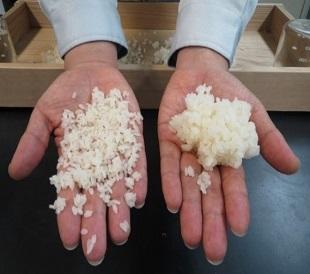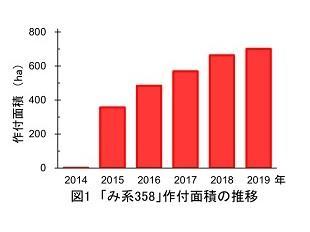Outcome Example of Bio-oriented Technology Research Advancement Institution
Issued on November 16, 2020




Rice malt brewing mellow and fragrant shochu
Unexpectedly, it is unknown that the rice components affect the fermentation and taste of shochu (Japanese sprits). The rice varieties for malt suitable for brewing shochu were created in Miyazaki and Kagoshima. They are "Mi-line 358" (Miyazaki) and "Takara masari" (Kagoshima), both of which are high amylose rice varieties containing a large amount of amylose, one of the starch components. We cultivated these varieties using a lot of manure to increase the protein content in rice, successfully producing high-quality malted rice. Because of the high-quality rice malt, shochu rich in flavor and fragrance could be brewed. The spread of local brand shochu products using these rice species may benefit both the brewers and rice farmers. It is expected that the region will be revitalized and the potential demand for shochu will be boosted, and the export of shochu will be promoted.
The choice of raw material rice is the key to obtaining high-quality rice malt
|
Typical raw materials of shochu include rice, barley, buckwheat, and sweet potato. Malt is necessary to ferment these raw materials and include various types of crop malts, rice malt and barley malt, for example. Rice malt is produced by following the procedure involving the steps of immersing rice in water; steaming the rice; cooling the steamed rice; sprinkling the seed malt over the cooled rice; fermenting in "Kojimuro (room for producing malted rice)." Then, water and shochu yeast are added to the rice malt to increase yeast; raw materials such as sweet potato are further added; the mixture is fermented for a given period. "Moromi (unrefined shochu)" produced in this manner is distilled to produce shochu with high alcohol concentration. The components of the raw material rice used in producing shochu malt determine the quality of brewed shochu and the workability in the shochu brewing process. The use of general sticky rice for cooking to produce malted rice prevents the malt mold from growing uniformly on every rice grain because of its sticky property. Moreover, adding excessive water in rice when steamed may lead to failure in producing shochu malt in certain cases. Against this background, brewers have eagerly requested the development of rice varieties suitable for shochu malt. |
 Non-sticky "Takara masari" (on your left side) On your right side, "Hi-no-Hikari" for cooking. Supplied by Kagoshima Administrative Office |
In response to this request, "high-amylose rice" was developed (Image 1). This variety of rice with less sticky and smooth food texture is suitable for curry and rice. High-amylose rice enables the malt mold to grow on every grain of rice and decompose starch and proteins. Accordingly, high-quality shochu malt with high enzyme activity is produced, thus generating tasty components.
An unexpectedly large amount of rice is used for shochu malt. When 200,000 tons of sweet potato is used for brewing imo-shochu (a spirit distilled from sweet potatoes), 40,000 tons of rice, equivalent to 1/5 of sweet potato, is necessary. An increase in demand for shochu leads to the enlargement of the area for cultivating rice for shochu malt, resulting in an increase in the incomes of farmers.
"Mi-line 358" from Miyazaki
|
"Mi-line 358" with high yield and blast resistance is intended to be used for shochu malt is a variety of rice grown at the Miyazaki Agricultural Experiment Station and this variety was registered in 2018. In the evaluation tests conducted by Miyazaki Administrative Office and brewers, this variety got a high estimation because the taste and sweetness of sweet potato were brought out. It was clarified that the earnings / 10a might be increased by a high-density raising seeding technology. The findings, which may lead to improve the incomes of rice farmers were produced; for example, high yield is expected using livestock dung compost as manure. The total area of cultivation of this variety (Fig.1) was enlarged to 701 ha in 2019. However, the yield of this variety has not yet met the demand from brewers; accordingly, further enlargement of the area of cultivation is required. |
 |
"Takara masari" from Kagoshima
"Takara masari," which attracts attention as a high-amylose rice variety, was bred at the Kagoshima Prefectural Institute for Agricultural Development primarily intended to be used for shochu malt. An application for variety registration was disclosed in July 2018 and a full-scale supply of seed was started in 2020. It is expected that the breeding of this variety will be spread in the future.
To achieve a high yield of "Takara masari" with fewer number ears, a combination of the high-density cultivation technique, by which the interrow is narrowed, and the heavy-manuring cultivation technique is required. The evaluation tests conducted by Kagoshima Prefectural Institute of Industrial Technology demonstrated that an increase in protein content in rice might improve the enzyme activity of malt, thus enhancing its fruity flavor. Moreover, it has been known that topdressing before and after ear emergence is effective in producing rice for shochu malt and it is expected that the fertilizing technique suitable for rice for shochu malt will be spread in the near future.
South Kyushu is the No. 1 place of producing shochu
According to a survey by JAPAN SAKE AND SHOCHU MAKERS ASSOCIATION, the shochu shipment (July 2019 to June 2020) from Miyazaki was ranked No.1 in Japan continuously over six years. Kagoshima was ranked No. 2 and Oita was No.3. The nationwide annual shochu shipment, 400,000 kL, has been decreasing. Note that additional efforts to recover the demand for shochu are required; for example, by improving the level of familiarity of "Honkaku (authentic) shochu" and " branded shochu" using rice species for shochu malt such as "Mi-line 358" and "Takara masari."
Project name
The special scheme project on advanced research and development for next-generation technology (Local strategy project)
Project period
FY 2016 to 2018
Title
Spreading of the rice varieties exclusively used for shochu malt adaptable to the South Kyushu Region and establishment of labor-saving and low-cost cultivation techniques
Research institutes
The Miyazaki Agricultural Experiment Station, Kagoshima Prefectural Institute of Industrial Technology, the Kagoshima Prefectural Institute for Agricultural Development, and others
